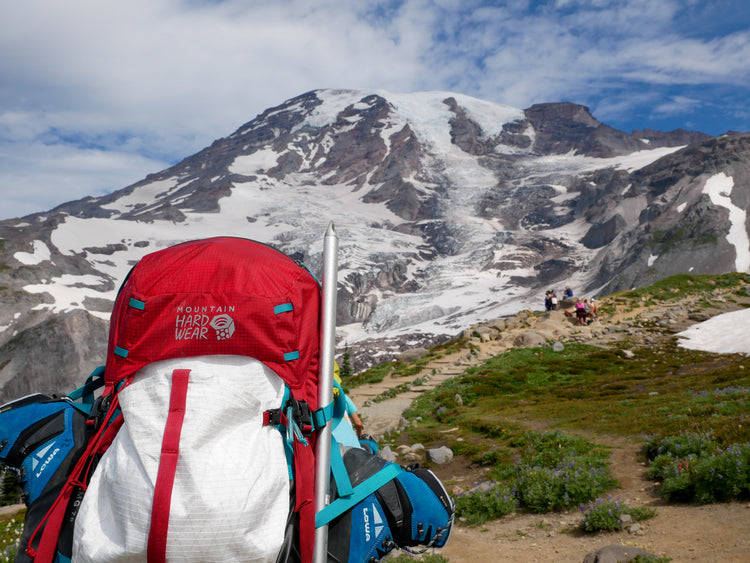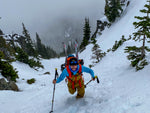If you’ve ever been mountaineering, you know how much gear you’ve got to lug along with you. Crampons, ice ax, helmet, harness, carabiners, ascenders, rope, food, water, sleeping bag, tent… the list goes on and on. Sure you’ll be wearing a lot of that gear some of the time, but for a big portion of your climb, you’ll be carrying all of it in your backpack.
Mountaineering Packs vs Backpacking Packs: What’s the Difference?
A backpack should carry everything you need on your adventure, ride reasonably comfortable on your back, and not have a lot of extra features “Bells and Whistles” that you do not need. While the differences might not be immediately noticeable, there are a few key things that set mountaineering packs apart. The first is attachment loops, which are super important for carrying your ice ax, trekking poles, and other pieces of gear on the outside of your pack. However, climbing packs should stay away from mesh side pockets, to make sure you don’t catch on any rocks. Backpacking packs also tend to have a removable flap separating the sleeping bag compartment from the main body of the pack, which ends up just being extra weight (remember, every ounce counts!). Mountaineering packs also tend to sit a bit higher up on your hips, so that the waist straps don’t interfere with your harness.
Mountaineering packs value simplicity above all else; in most cases, all you need is a single big main pocket with an adjustable “brain” or top pocket. The less going on with your pack, the less likely you’ll have to try an impromptu fix when something breaks at altitude. But simple doesn’t mean shabby! Good mountaineering packs will be built with durable materials, and while waterproofing isn’t totally necessary, it can definitely come in handy.
Which Backpack is Right For Me?
That depends! There are a lot of factors that go into choosing the perfect backpack, but here are some things to think about:
How long is your climb?
The more time you spend on the mountain, the more gear you’re going to need, and the bigger your pack should be. That one’s pretty obvious, but you should also take your approach into account. Are you strictly mountaineering, getting up on glaciers right away? Or do you have to trek into the base for a few days first, in which case you might want something a little bigger and more comfortable?
Who are you?
Don’t worry, we’re not asking you to question your existence. But knowing “who” you are is important in picking the right pack. For instance, are you an experienced climber who knows what you need and wants to go fast and light? Or are you a client with a guided program, who might want to bring along a few creature comforts? Gender matters too; even though most mountaineering packs are gender-neutral, there are a few brands that specialize in men’s or women's packs.
Our Guide Pick™ Recommendations
Every year, we survey the guides at our sister company RMI Expeditons, to get their input on the gear they recommend for their clients, and themselves. Here are a few of this year’s Guide Pick™ backpacks.
Best Day Pack
Black Diamond Speed 30: If you’re going a one day climb, there is no better pack than the BD Speed 30. Super lightweight, with removable lib, waistbelt, and framesheet, and sporting ice tool PickPockets and snag free crampon straps, this pack is made for mountaineering.
Best Short (2-4 Day) Expedition Pack
Black Diamond Mission 75: Built for alpine climbing, the Mission 75 is super durable, lightweight, and free of unnecessary bells and whistles. It carries well both full and half empty, so you’ll be comfortable whether you’re walking up the snow field or pushing for the summit with only the essentials.
Best Women’s Specific Expedition Pack
Osprey Ariel 65: Built specifically for women, the Ariel 65 is great for a multi-day expedition. With a Custom Fit-on-the-Fly waistbelt and a ton of overall adjustment, the Ariel 65 is fine-tuned to fit a variety of body shapes and sizes.
Best Long (5+ Day) Expedition Pack
Mountain Hardwear AMG 105: Designed with big expeditions in mind, the AMG 105 is one of the few framed packs we recommend for mountaineering. A lightweight aluminum frame helps support the big loads you’ll be carrying to basecamp, without adding unnecessary weight on your summit push.
Questions on backpacks? Ask away in the comments below!
As always,
Happy Climbing!


